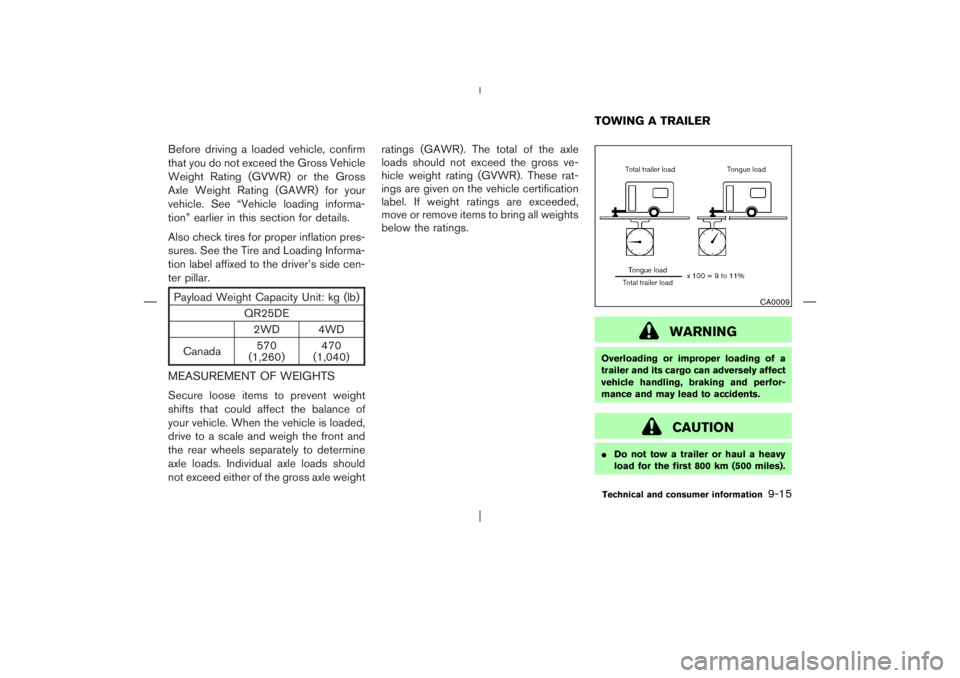Page 248 of 281

9 Technical and consumer informationCapacities and recommended fuel/lubricants .............. 9-2
Fuel recommendation .................................................... 9-3
Engine oil and oil filter recommendation .................. 9-5
Recommended SAE viscosity number ...................... 9-6
Air conditioning system refrigerant and lubricant
recommendations ........................................................... 9-6
Specifications ........................................................................ 9-7
Engine ................................................................................ 9-7
Wheels and tires ............................................................. 9-8
Dimensions and weights ............................................... 9-8
When traveling or registering your vehicle in another
country ..................................................................................... 9-9
Vehicle identification ............................................................ 9-9
Vehicle identification number (VIN) plate ................. 9-9
Vehicle identification number (Chassis number) .... 9-9
Engine serial number ................................................... 9-10
C.M.V.S.S. certification label ..................................... 9-10
Emission control information label ........................... 9-10
Tire and loading information label ............................ 9-11Air conditioner specification label ............................ 9-11
Vehicle loading information ............................................. 9-11
Terms ............................................................................... 9-11
Vehicle load capacity .................................................. 9-12
Loading tips ................................................................... 9-14
Payload weight capacity ............................................. 9-14
Measurement of weights ............................................ 9-15
Towing a trailer ................................................................... 9-15
Maximum load limits .................................................... 9-16
Towing load/specification chart ............................... 9-18
Towing safety ................................................................ 9-18
Flat towing ....................................................................... 9-21
Uniform tire quality grading ............................................. 9-22
Emission control system warranty ................................. 9-23
Readiness for inspection/maintenance (I/M) test ...... 9-23
Event data recorders ......................................................... 9-24
Owner’s manual/service manual order information ... 9-25
In the event of a collision ........................................... 9-25
�
06.4.14/T30-J/V5.0
�
Page 261 of 281

the vehicle. That weight may not safely
exceed the available cargo and lug-
gage load capacity calculated in Step
4.
6. If your vehicle will be towing a trailer,
load from your trailer will be trans-
ferred to your vehicle. Consult this
manual to determine how this reduces
the available cargo and luggage load
capacity of your vehicle.
Before driving a loaded vehicle, confirm
that you do not exceed the Gross Vehicle
Weight Rating (GVWR) or the Gross
Axle Weight Rating (GAWR) for your
vehicle.
See “Measurement of Weights” later in
this section.
Also check tires for proper inflation pres-
sures. See the Tire and Loading Informa-
tion label.
LOADING TIPSThere are luggage hooks located in the
cargo area. The luggage hooks can beused to secure cargo with ropes or other
types of straps.
�The GVW must not exceed GVWR or
GAWR as specified on the
F.M.V.S.S./C.M.V.S.S. certification la-
bel.
�Do not load the front and rear axle to
the GAWR. Doing so will exceed the
GVWR.
WARNING
�Properly secure all cargo with
ropes or straps to help prevent
it from sliding or shifting. Do
not place cargo higher than the
seatbacks. In a sudden stop or
collision, unsecured cargo
could cause personal injury.
�Do not load your vehicle any
heavier than the GVWR or the
maximum front and rear
GAWRs. If you do, parts of yourvehicle can break, tire damage
could occur, or it can change
the way your vehicle handles.
This could result in loss of con-
trol and cause personal injury.
�Overloading not only can
shorten the life of your vehicle
and the tire, but can also cause
unsafe vehicle handling and
longer braking distances. This
may cause a premature tire fail-
ure which could result in a seri-
ous accident and personal in-
jury. Failures caused by
overloading are not covered by
the vehicle’s warranty.
PAYLOAD WEIGHT CAPACITYThe payload weight capacity is the maxi-
mum total weight of passengers, optional
equipment (air conditioning, trailer hitch,
etc.) and cargo that your vehicle is de-
signed to carry.
9-14
Technical and consumer information
�
06.4.14/T30-J/V5.0
�
Page 262 of 281

Before driving a loaded vehicle, confirm
that you do not exceed the Gross Vehicle
Weight Rating (GVWR) or the Gross
Axle Weight Rating (GAWR) for your
vehicle. See “Vehicle loading informa-
tion” earlier in this section for details.
Also check tires for proper inflation pres-
sures. See the Tire and Loading Informa-
tion label affixed to the driver’s side cen-
ter pillar.Payload Weight Capacity Unit: kg (lb)
QR25DE
2WD 4WD
Canada570
(1,260)470
(1,040)MEASUREMENT OF WEIGHTSSecure loose items to prevent weight
shifts that could affect the balance of
your vehicle. When the vehicle is loaded,
drive to a scale and weigh the front and
the rear wheels separately to determine
axle loads. Individual axle loads should
not exceed either of the gross axle weightratings (GAWR). The total of the axle
loads should not exceed the gross ve-
hicle weight rating (GVWR). These rat-
ings are given on the vehicle certification
label. If weight ratings are exceeded,
move or remove items to bring all weights
below the ratings.
WARNING
Overloading or improper loading of a
trailer and its cargo can adversely affect
vehicle handling, braking and perfor-
mance and may lead to accidents.
CAUTION
�Do not tow a trailer or haul a heavy
load for the first 800 km (500 miles).
CA0009
TOWING A TRAILERTechnical and consumer information
9-15
�
06.4.14/T30-J/V5.0
�